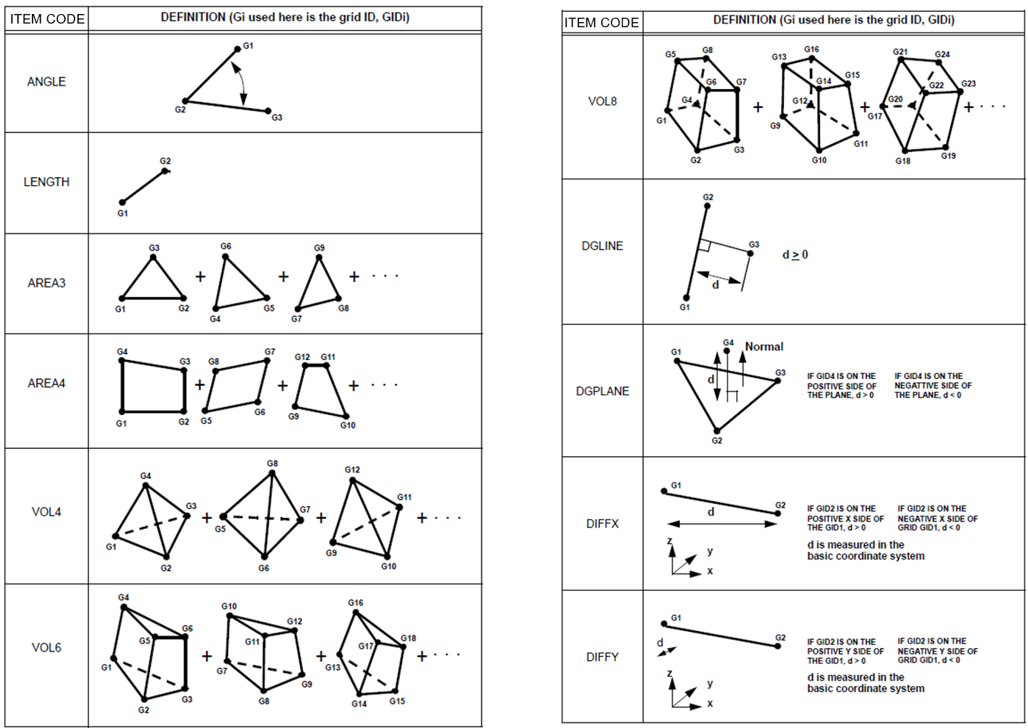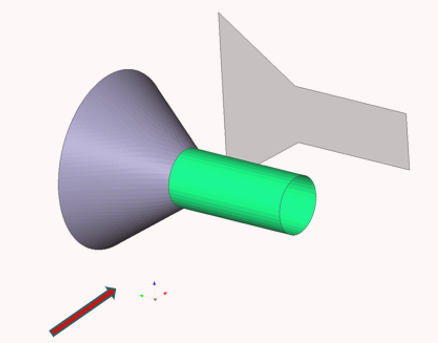Subcase Independent
Mass and Volume
Both are global responses that can be defined for the whole structure, for individual properties (components) and materials, or for groups of properties (components) and materials.
It is not recommended to use mass and volume as constraints or objectives in a topography optimization. Neither is very sensitive towards design modifications made in a topography optimization.
In order to constrain the mass or volume for a region containing a number of properties (components), the SUM function can be used to sum the mass or volume of the selected properties (components), otherwise, the constraint is assumed to apply to each individual property (component) within the region. Alternatively, a DRESP2 equation needs to be defined to sum the mass or volume of these properties (components). This can be avoided by having all properties (components) use the same material and applying the mass or volume constraint to that material.
RTYPE=VOLUME and ATTA=ENCLOSED can be used to create an enclosed volume response for Shape, Free-Shape, and Topography optimization. The ENCLOSED option indicates that this response is an enclosed volume defined by a closed 2D mesh (free-edges are not supported). For this enclosed volume response type, ATTI field(s) should be set to PID. Multiple ATTi are allowed, as long as the mesh defined by the PID's is fully enclosed. The property type should be PSHELL, PCOMP, or PSHEAR only. The normals of the 2D mesh should be oriented consistently and the mesh should be sufficiently fine to capture the volume data. The volume is calculated based on the mesh and it is not recommended to use a coarse mesh.
Fraction of Mass and Fraction of Design Volume
Both are global responses with values between 0.0 and 1.0. They describe a fraction of the initial design space in a topology optimization. They can be defined for the whole structure, for individual properties (components) and materials, or for groups of properties (components) and materials.
The difference between the mass fraction and the volume fraction is that the mass fraction includes the non-design mass in the fraction calculation, whereas the volume fraction only considers the design volume.
Volume fraction = (total volume at current iteration - initial non-design volume)/initial design volume
Mass fraction = total mass at current iteration/initial total mass
If, in addition to the topology optimization, a size and shape optimization is performed, the reference value for the volume fraction (the initial design volume) is not altered by size and shape changes. This can, on occasion, lead to negative values for this response. Therefore, if size and shape optimization is involved, it is recommended to use the Volume responses instead of the Volume Fraction response.
These responses can only be applied to topology design domains. OptiStruct will terminate with an error if this is not the case.
Center of Gravity
This is a global response that may be defined for the whole structure, for individual properties (components) and materials, or for groups of properties (components) and materials.
By default, the center of gravity response is calculated with respect to the basic coordinate system. Refer to PARAM, UCORD to specify a user-defined coordinate system for the calculations.
Moments of Inertia
This is a global response that may be defined for the whole structure, for individual properties (components) and materials, or for groups of properties (components) and materials.
By default, the moment of inertia response is calculated with respect to the basic coordinate system. Refer to PARAM, UCORD to specify a user-defined coordinate system for the calculations.
Weighted Compliance
The weighted compliance is a method used to consider multiple subcases (loadsteps, load cases) in a classical topology optimization. The response is the weighted sum of the compliance of each individual subcase (loadstep, load case).
This is a global response that is defined for the whole structure.
Weighted Reciprocal Eigenvalue (Frequency)
The weighted reciprocal eigenvalue is a method to consider multiple frequencies in a classical topology optimization. The response is the weighted sum of the reciprocal eigenvalues of each individual mode considered in the optimization.
This is done so that increasing the frequencies of the lower modes will have a larger effect on the objective function than increasing the frequencies of the higher modes. If the frequencies of all modes were simply added together, OptiStruct would put more effort into increasing the higher modes than the lower modes. This is a global response that is defined for the whole structure.
Combined Compliance Index
The combined compliance index is a method to consider multiple frequencies and static subcases (loadsteps, load cases) combined in a classical topology optimization. The index is defined as:
This is a global response that is defined for the whole structure.
The normalization factor, , is used to normalize the contributions of compliances and eigenvalues. A typical structural compliance value is of the order of 1.0e4 to 1.0e6. However, a typical inverse eigenvalue is on the order of 1.0e-5. If NORM is not used, the linear static compliance requirements dominate the solution.
The quantity is typically computed using the formula:
Where, is the highest compliance value in all subcases (loadsteps, load cases) and is the lowest eigenvalue included in the index.
In a new design problem, you may not have a close estimate for . If this happens, OptiStruct automatically computes the value based on compliances and eigenvalues computed in the first iteration step.
Bead Discreteness Fraction
This is a global response for topography design domains. This response indicates the amount of shape variation for one or more topography design domains. The response varies in the range 0.0 to 1.0 (0.0 < BEADFRAC < 1.0), where 0.0 indicates that no shape variation has occurred, and 1.0 indicates that the entire topography design domain has assumed the maximum allowed shape variation.
Geometric
- LENGTH
- The response is the sum of the distances between consecutive pairs of grids in the ATTi list.
- ANGLE
- The response is the angle formed between the line defined by the locations of grids GID2 and GID1 and the line defined by the locations of grids GID2 and GID3.
- AREA3/AREA4
- The response is the sum of areas defined by the grids. The order of the listed grids is important and follows the grid sequence used in first-order shell elements, such as CTRIA3 and QUAD4 elements.
- VOL4/VOL5/VOL6/VOL8
- The response is the sum of volumes defined by the grids. The order of the listed grids is important and follows the grid sequence used in first-order solid elements, such as TETRA, PYRA, PENTA, and HEXA elements.
- DGLINE
- The response is the distance between GID3 and the line defined by GID1 and GID2.
- DGPLANE
- The response is the distance between the location of grid GID4 and the plane defined by the locations of grids GID1, GID2, and GID3. If GID4 lies on the positive side of the plane (determined by the plane's normal vector), the distance is positive. The normal vector is constructed using the locations of grids GID1, GID2, and GID3.
- DIFFX/DIFFY/DIFFZ
- The response is the difference in the x, y, or z coordinates (respectively) between G2 and G1 in the basic coordinate system. This value can be positive, zero, or negative.
- DISTX/DISTY/DISTZ
- The response is the absolute difference between the x, y, or z coordinates (respectively) of G2 and G1 in the basic coordinate system. This value can only be positive or zero.
- LOCX/LOCY/LOCZ
- The response is the x, y, or z coordinate value (respectively) of G1 in the basic coordinate system. This value can be positive, zero, or negative.

Projected Geometric
A projected geometric response is a load-independent geometric response that can be selected using RTYPE = GEORESP. These responses are functions of the grid or element IDs specified in the ATTi fields of the DRESP1 entry.
There are nine types of projected geometric responses available, all controlled by ATTA. PXAREA3, PYAREA3, PZAREA3, PXAREA4, PYAREA4, and PZAREA4 types are defined by grid IDs. PXAREA, PYAREA, and PZAREA types are defined by shell element IDs.
- The x-axis of the coordinate system defines the direction of the light projected onto the area for PXAREA3, PXAREA4, and PXAREA.
- The y-axis of the coordinate system defines the direction of the light projected onto the area for PYAREA3, PYAREA4, and PYAREA.
- The z-axis of the coordinate system defines the direction of the light projected onto the area for PZAREA3, PZAREA4, and PZAREA.
